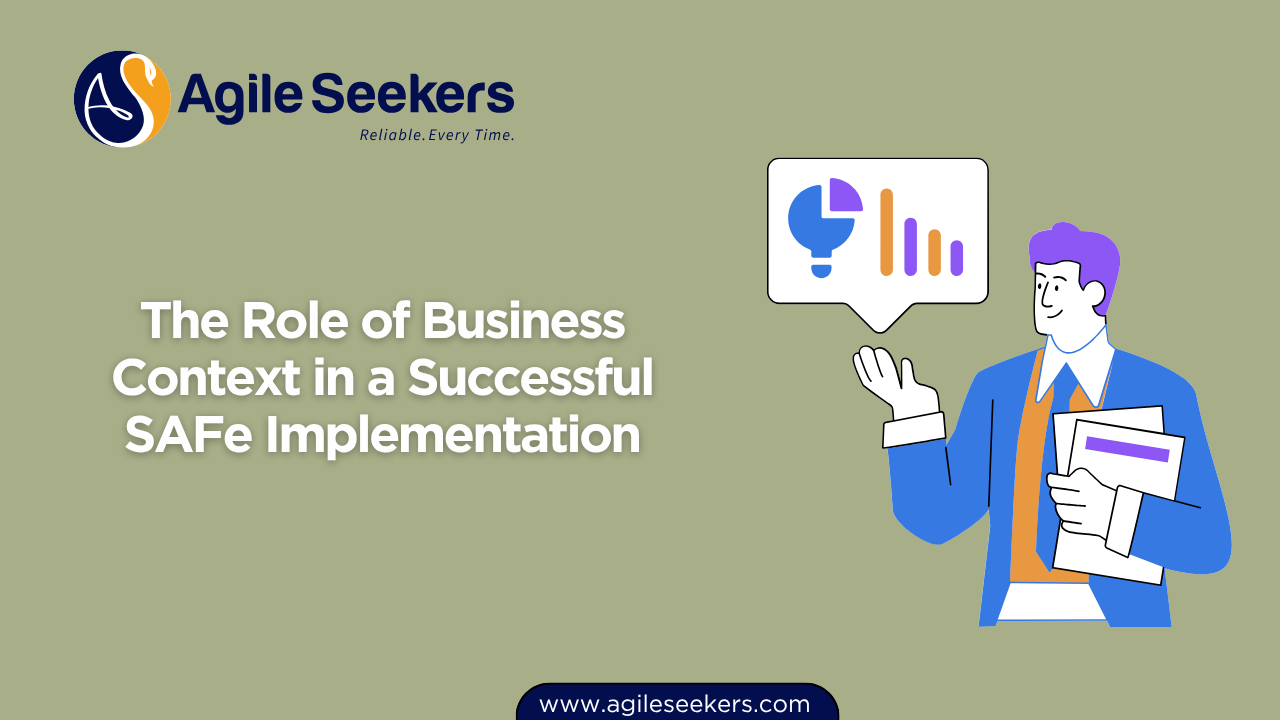The Role of Business Context in a Successful SAFe Implementation

A Scaled Agile Framework (SAFe) implementation cannot succeed if it’s treated as a rigid, one-size-fits-all model. Many organizations jump into SAFe thinking it's just about ceremonies, roles, and artifacts. They overlook a crucial factor—business context. Without anchoring SAFe to the company’s unique goals, culture, and constraints, teams end up mechanically following processes without creating real value.
In this post, we’ll explore why business context matters in SAFe, how it shapes every level of implementation, and what roles are responsible for maintaining this alignment.
What Do We Mean by “Business Context”?
Business context includes a company’s vision, goals, customer needs, regulatory environment, competitive landscape, internal capabilities, and economic constraints. It provides the “why” behind decisions, investments, and delivery priorities.
SAFe encourages enterprises to define this explicitly through tools like Strategic Themes, Portfolio Vision, and Value Stream identification. But writing these down isn’t enough. The business context needs to be understood, communicated, and continuously reflected in every planning session, backlog refinement, and prioritization effort.
Why SAFe Without Business Context Fails
-
Misaligned Priorities
Without a clear business context, teams optimize for local efficiency rather than strategic outcomes. Features get delivered, but customer or market impact remains low. -
Overhead Without Value
SAFe roles and ceremonies can become burdensome rituals when they’re not connected to actual business needs. Teams may burn capacity chasing velocity, not value. -
Resistance to Change
Employees are less likely to support transformation efforts when they can’t tie new ways of working to real-world improvements in business performance.
Business Context Must Drive Portfolio and Value Stream Thinking
At the portfolio level, SAFe encourages alignment through Strategic Themes and Guardrails, which tie Epics and budgets to business strategy. However, defining these in isolation from context leads to misalignment. Leaders with Leading SAFe Agilist Certification are trained to ensure that strategy is not only set but also continuously reinforced across portfolios and programs.
Meanwhile, value streams should reflect how the business delivers value to customers—not how teams are currently organized. Getting this wrong results in fragmented execution and delayed feedback loops. Mapping value streams in context ensures funding and ARTs are aligned to real customer journeys, not internal silos.
External read: Value Stream Identification on the official SAFe site provides helpful guidance on aligning with business context.
PI Planning Must Start with Business Context
Program Increment (PI) Planning is a cornerstone of SAFe, but without a strong understanding of the business context, it becomes a glorified scheduling exercise. PI Planning should open with a Business Owners’ briefing that clearly lays out:
-
Customer priorities
-
Market conditions
-
Regulatory considerations
-
Financial outlook
-
Strategic risks and opportunities
This aligns teams toward a shared mission, not just a shared backlog. Teams with certified SAFe Scrum Masters and SAFe Advanced Scrum Masters play a vital role in ensuring this business alignment carries into team-level execution.
Product Owners and Business Context: Daily Alignment
SAFe Product Owner/Product Manager Certification holders are trained to act as the voice of the customer and the business. They don’t just manage the backlog—they shape it based on continuous feedback from business stakeholders and the external environment.
Good PO/PMs keep a constant pulse on:
-
Business objectives and KPIs
-
Market signals
-
Sales and support insights
-
Customer satisfaction metrics
They ensure each feature and user story can be traced back to a business need. This traceability is essential for making economic trade-offs and defending prioritization decisions during WSJF scoring or backlog grooming.
RTEs Keep Business Context Alive Across ARTs
The SAFe Release Train Engineer Certification focuses on enabling flow, removing impediments, and facilitating alignment across teams. RTEs aren’t just delivery coordinators—they’re connectors of context.
They help ARTs maintain alignment with business goals throughout the PI by:
-
Reinforcing the Business Owner vision in ART Syncs
-
Ensuring Inspect & Adapt workshops drive business-relevant learning
-
Encouraging cross-team collaboration in service of customer outcomes
External reference: Inspect & Adapt sessions in SAFe help identify where the business context may have drifted during execution.
Common Pitfalls When Business Context Is Missing
-
Teams Build the Wrong Thing Faster
Agile becomes dangerous when speed increases but direction is unclear. -
Over-reliance on Framework Rules
Without context, SAFe becomes a checklist rather than a decision-making aid. -
Fragmented Stakeholder Expectations
Business and technology leaders interpret success differently, creating tension.
Embedding Business Context in the Culture
Business context should be built into the culture, not just presented at quarterly meetings. Here's how to do that:
-
Leaders talk outcomes, not just activity
Metrics should reflect business impact—revenue, customer NPS, market share—not just team throughput or burn-downs. -
Include Business Owners in retros and demos
Their feedback helps teams see the real-world value (or gaps) of their work. -
Create transparency through visuals
Tools like Lean Business Canvas, Value Stream Mapping, and Portfolio Kanban help everyone stay aligned. -
Train and certify across roles
Ensure your Scrum Masters, Product Owners, and leaders are equipped to interpret and apply business context effectively. This is where SAFe certifications play a critical role in setting a consistent foundation.
Conclusion
SAFe implementation isn’t a paint-by-numbers activity. It only delivers business agility when context becomes the lens through which every role, event, and decision is made. Leaders must embed business goals at the heart of Agile Release Trains. Product Owners must shape backlogs based on evolving strategy. Scrum Masters and RTEs must reinforce alignment across teams.
If you’re implementing SAFe and not actively leveraging business context—you’re only going halfway. Put the “why” at the center, and the “how” will follow with purpose.
Also read - How to Align Agile Transformation with Business Strategy Using SAFe
Also See - Strategic Alignment in SAFe: Why It’s the First Step Toward Business Agility




















